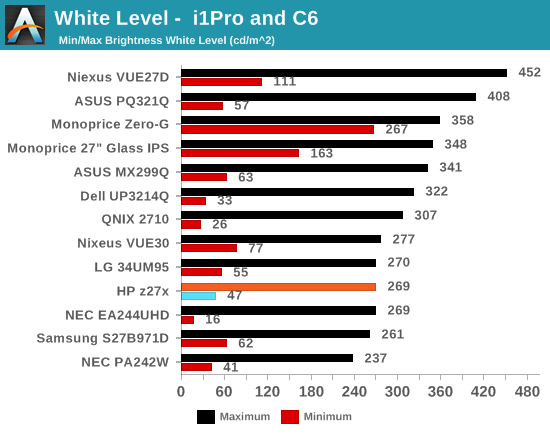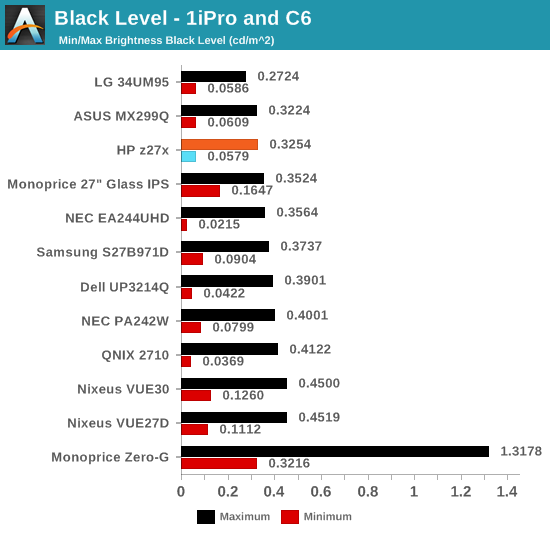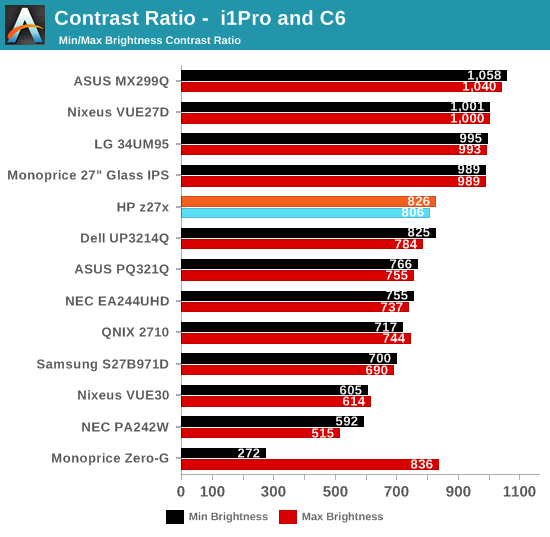HP z27x Review
by Chris Heinonen on December 2, 2014 4:00 PM ESTWith the backlight set to maximum, you only get 269 cd/m2 of brightness from the HP z27x. Many displays can go much brighter, but the z27x is meant to be used in more of a professional, production environment. Bright overhead lighting or direct sunlight are not going to be as much of a problem here, so you don’t need 350-400 cd/m2 to try to overcome those issues. It won’t work as well for such environments but you shouldn’t be using a $1,500 monitor in those situations either. At minimum brightness we get 47 cd/m2 of brightness. This is low enough for any real world use without going down to the unusable levels that some displays do.

Black levels are consistent with other professional level IPS panels. They are not as dark as an IPS panel can be, as the recent Retina iMac would demonstrate, but other performance aspects are more important than absolute black. The z27x would be improved by a better black level, but most of its target users should be fine with what it achieves.

The resulting contrast ratios here are around 815:1, or average for an IPS panel. There is no backlight control or anything else to enhance these beyond what they are. Under 1,000:1 is beginning to be not so great for an IPS panel, though almost all professional panels from NEC or others also fall into this range. It might seem strange that a professional display would value black levels less than a consumer one, but having an even gamma curve with visible shadow details is more important and contrast ratio can be sacrificed to achieve that,

The HP z27x data so far goes along with what I expect from a professional level display. Consumers that plan to watch movies and play games on their display might be happier with a display with improved contrast ratios. Professionals after different performance measures should be happy with the z27x numbers.










47 Comments
View All Comments
Olaf van der Spek - Wednesday, December 3, 2014 - link
Cheap? It might not be as expensive as this one but the ZR2704w isn't cheap.DiHydro - Tuesday, December 2, 2014 - link
To me, that uniformity error looks like problems I've seen in monitors with bent or squashed frames. Sometimes in shipping, the inner metal frame can bend or get squeezed, and this will cause the diffuser to get moved slightly closer to the screen or away. This will case atypical uniformity along the edges of the monitor. Does this monitor have a very sturdy outer casing? Was it picked up by one side, or maybe bent just a little while unpacking? It's certainly worth investigating for such a strange result.joelypolly - Tuesday, December 2, 2014 - link
Would be interesting if liquidmetal will ever be used as internal framing due to its more crystalline structure which is less likely to bend or warp.anactoraaron - Tuesday, December 2, 2014 - link
I was thinking the same thing, especially since it's in the top corner.mapesdhs - Tuesday, December 2, 2014 - link
Amusing that so much is being made of 4K issues for professionals, when studios are
already working with 8K. :D For example, see the article on creativecow entitled,
"Quantel Unveils 8K 60p Pablo Rio Workflow" (they use quad-4K monitors for preview,
three Tesla K80s for processing).
Ian.
tyger11 - Tuesday, December 2, 2014 - link
Maybe _some_ are working with 8K, but most high-end cinematographers say they don't want more resolution than 4K, they want much more dynamic range. I saw a discussion panel with 3-4 very high-end hollywood cinematographers, and every one of them were disinterested in resolutions higher than 4K, but were salivating at next year's big expected jump in dynamic range (in the area of 20-21 stops of DR). If we can get rid of the Bayer sensor once and for all, 4K resolution will have a noticeable amount of increased detail; no need for any more than that, even in a cinema setting. More DR - especially if we can get to 20-21 stops - will be huge.Doach - Tuesday, December 2, 2014 - link
I really dont know what to say. I dont think you realize what display you are reviewing. Or know the history behind the dreamcolor display. Know this. A retina display from a 5k imac cannot come close to the performance of the display you just reviewed. Not even in the same ballpark. Do you even now that this is a dreamcolor display? From the article it appears you do not. They really dont need any introduction as most movie production companies use these displays.You just reviewed a display that was damaged in shipping, which would impact all aspects of your review. Black levels, uniformity etc.
That monitor was damaged in shipping. I work for dreamworks and we have several of these. We had one with the same problem. The box it came in was damaged on one side.
You should have called tech support before writing this review and got another one. Saying that this shipped from the factory like that to your readers implies that HP has a quality issue is amatuer at best without knowing for sure.
There is a reason we use dreamcolor displays and not NEC displays. It seems you need to reeducate your self on why rec 2020 is important in a professional display.
Poorly written review. You guys need to do better if you want to be taken seriously by the professional community. Anand was more through and would contact the company first before writing such a review. You just threw them (HP)under the bus over a shipping error.
These monitors are calibrated and tested for accuracy and yes uniformaty issues before they leave the factory. If they were not they would not be used very long by the professional community. As it stands now HP dreamcolor displays own the professional market.
You should know this. If you do not you should not be writing articles for anandtech.
Techinator - Tuesday, December 2, 2014 - link
I'm sorry, but there's an awful lot of arrogance in your comment. How do *you* know the box was damaged in shipping? You're making a pretty big assumption there, and you know what they say about those. But let me just make sure you understand what I'm saying: you are being a complete ASS in your comment. There. We're now clear.I could say more, but there's not much point. You're so biased that you can't even objectively point out problems with the review and resort to simple blanket statements. "Poorly written" -- what part, the part where he ran all the tests, talked about why Rec 2020 and other wide gamut options matter, and all of the other text? Or just the part where he showed that HP sent a reviewer a display that clearly has a uniformity problem?
anactoraaron - Tuesday, December 2, 2014 - link
Yeah, but he may have a point about it being damaged in shipping. None of the other $1k+ displays reviewed here are THAT off in one corner. A quick email to HP about this should have been done.cheinonen - Wednesday, December 3, 2014 - link
If I were to request a new sample from HP, then I'd be accused of having HP pick me out a perfect review sample that isn't anything like what they ship to people buying one. If I don't, then I get these comments. As I said, the only real negative about the HP is the uniformity on mine. This is my 2nd sample, as the first developed a pink stripe and HP replaced it. However, I've not had the same uniformity issues with samples from NEC in their professional lines. Perhaps they hand pick them, or perhaps their packaging (which is the best out there, IMO) helps to prevent these issues.There's a very good chance this is just a sample issue and most don't have this problem, but unless I get in 20 samples to test I really won't know.